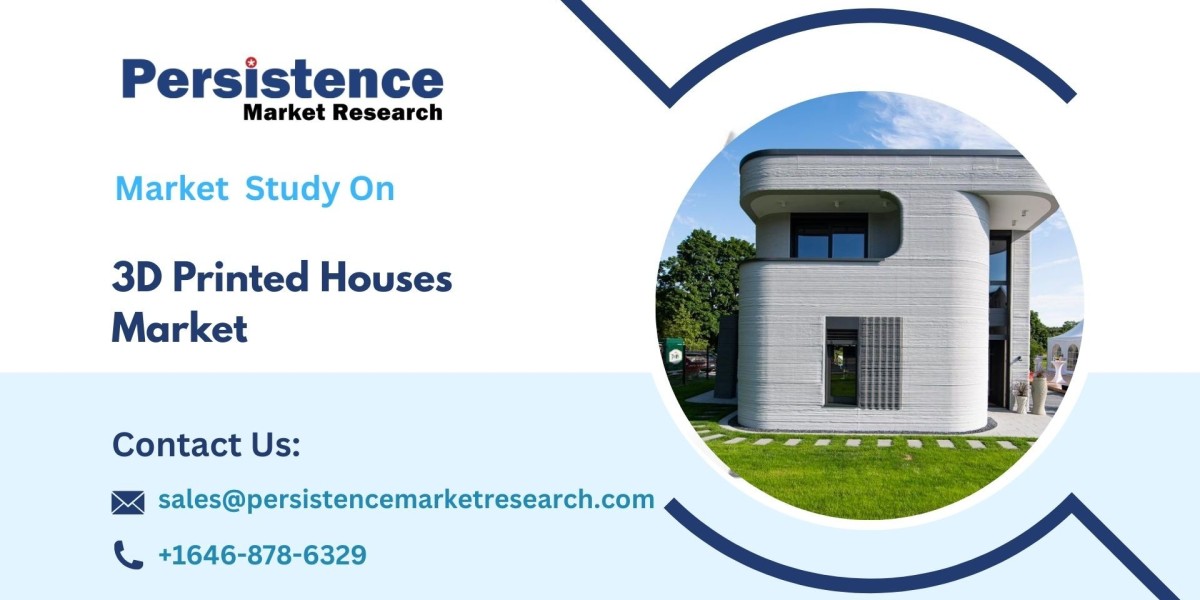Overview of the 3D Printed Houses Market
The global 3D printed houses market is witnessing a groundbreaking transformation in the construction industry, fueled by rapid advancements in additive manufacturing technologies. This market represents an innovative shift from conventional construction methods, leveraging 3D printing to fabricate housing structures layer by layer. By combining speed, precision, and sustainable practices, 3D printed houses are redefining the way residential and commercial buildings are designed and constructed. According to current projections, the market is expected to grow from US$35 million in 2024 to US$1,436.2 million by 2031, registering a remarkable CAGR of 70%. This growth reflects the increasing adoption of 3D printing technology in construction projects worldwide, driven by demand for cost-effective, efficient, and environmentally sustainable building solutions.
The leading segment in this market is residential housing, due to the pressing global need for affordable and customizable homes. Residential projects benefit most from the speed, flexibility, and material efficiency offered by 3D printing. In terms of geography, North America currently dominates the 3D printed houses market, owing to strong government support, investments in research and development, and a focus on sustainable and eco-friendly construction practices. The U.S., in particular, has facilitated the adoption of this technology through initiatives led by the Department of Housing and Urban Development (HUD) and other agencies, encouraging the use of 3D printing for disaster relief housing and affordable construction projects.
Key Highlights from the Report
• The 3D printed houses market is projected to reach US$1,436.2 million by 2031.
• North America is the leading market due to government support and sustainability initiatives.
• Residential housing dominates the market, driven by demand for affordable and customizable homes.
• Rapid construction speed and reduced labor costs are major growth drivers.
• Sustainable materials and eco-friendly practices enhance market adoption.
• Technological advancements in 3D printing enable complex architectural designs.
Market Segmentation
The 3D printed houses market is segmented based on product type, construction method, and end-user applications. By product type, the market includes pre-fabricated 3D printing systems and on-site 3D printing technologies, with on-site printing gaining traction due to its flexibility and scalability. Residential buildings represent the primary end-user segment, including single-family homes, multi-family complexes, and affordable housing projects. Commercial and industrial applications are gradually emerging, with 3D printing used for offices, hotels, and temporary structures. Additionally, market segmentation by construction material highlights the use of concrete, polymers, and composite materials, with sustainable and recycled materials increasingly preferred for eco-friendly housing solutions. This segmentation strategy allows manufacturers and developers to cater to diverse project needs while optimizing cost and construction efficiency.
Regional Insights
Regional trends in the 3D printed houses market highlight varying levels of adoption and market potential. North America is at the forefront due to proactive government initiatives, strong investment in technology, and heightened demand for sustainable housing solutions. The U.S. and Canada are leading in research and pilot projects for disaster relief housing and affordable homes. Asia Pacific is emerging as a high-growth region, driven by rapid urbanization, government-led affordable housing programs, and active participation of innovative companies like Winsun in China. Countries such as Singapore and China are exploring large-scale 3D printed housing solutions to address urban housing shortages. Europe is witnessing steady adoption, particularly in countries with strong environmental regulations and interest in green construction. Emerging markets in Latin America and the Middle East are gradually exploring 3D printed construction, primarily in the affordable housing and disaster relief segments.
Market Drivers
The growth of the 3D printed houses market is primarily driven by innovative construction techniques, cost efficiency, and sustainability considerations. Additive manufacturing enables faster construction timelines, reduced labor requirements, and precise material utilization, creating significant cost advantages over traditional building methods. Architects and developers benefit from enhanced design flexibility, allowing the construction of intricate and customizable structures previously unattainable with conventional methods. Furthermore, 3D printing aligns with the growing demand for sustainable construction, as many printing technologies utilize recycled materials, eco-friendly concrete, or bio-based polymers. The combination of speed, affordability, and environmental benefits makes 3D printed houses an attractive solution for addressing global housing challenges.
Market Restraints
Despite its growth potential, the 3D printed houses market faces several challenges. Regulatory hurdles remain a primary restraint, as existing building codes and safety standards are largely designed for traditional construction techniques. Companies often encounter difficulties in obtaining permits for 3D printed structures, and lack of standardized guidelines slows adoption. Technological limitations also pose challenges, particularly in the development of high-strength, weather-resistant materials suitable for large-scale housing projects. Variations in printing parameters, environmental conditions, and material quality can affect structural integrity, requiring continued research and development to ensure consistent and reliable construction outcomes.
Market Opportunities
The global 3D printed houses market presents opportunities for sustainable urban development and personalized housing solutions. Rapid urbanization and rising housing costs have created demand for cost-efficient, eco-friendly construction methods. 3D printed houses enable the creation of entire sustainable communities incorporating renewable energy systems, rainwater harvesting, and green spaces. Additionally, customization and personalization options allow homeowners to design tailored living spaces with optimized layouts and aesthetic appeal. The growing interest in innovative, sustainable, and flexible housing solutions positions the 3D printed houses market for long-term expansion, attracting developers, investors, and environmentally conscious consumers.
Reasons to Buy the Report
• Comprehensive analysis of global 3D printed houses market trends and growth drivers.
• Detailed segmentation insights for residential, commercial, and material-specific applications.
• Regional market trends and forecasts with actionable investment guidance.
• Competitive intelligence and analysis of key players’ strategies.
• Insights into emerging opportunities, technological innovations, and sustainability trends.
Frequently Asked Questions (FAQs)
• How Big is the 3D Printed Houses Market?
• Who are the Key Players in the Global 3D Printed Houses Market?
• What is the Projected Growth Rate of the 3D Printed Houses Market?
• What is the Market Forecast for 3D Printed Houses for 2032?
• Which Region is Estimated to Dominate the Industry through the Forecast Period?
Company Insights
Key players in the 3D printed houses market include:
• ICON
• Apis Cor
• Winsun
• Mighty Buildings
• COBOD
• Contour Crafting Corporation
• Fbure
• CyBe Construction
• Total Kustom
Recent Developments:
• ICON Unveils "Vulcan II" 3D Printer: This advanced model enables faster, larger, and more complex constructions, enhancing market adoption and scalability.
• Apis Cor Launches Mobile 3D Printing System: The portable system allows on-site construction, reducing costs and increasing flexibility for diverse projects.
Conclusion
The global 3D printed houses market is poised for remarkable growth, driven by technological advancements, cost efficiency, and sustainability trends. With the residential segment leading adoption and North America at the forefront, 3D printed houses are reshaping traditional construction paradigms. Challenges such as regulatory barriers and material limitations exist, yet opportunities for sustainable urban development and personalized housing solutions provide immense potential. Companies like ICON, Apis Cor, and Winsun are pioneering innovative technologies and eco-friendly practices, strengthening market competitiveness. As demand for affordable, efficient, and environmentally conscious housing continues to rise, the 3D printed houses market is set to transform the future of residential and commercial construction globally, offering lucrative opportunities for investors, developers, and technology innovators.
??????? ???????:






